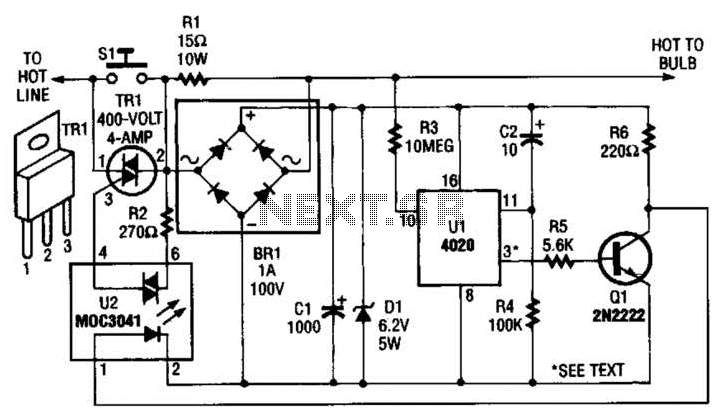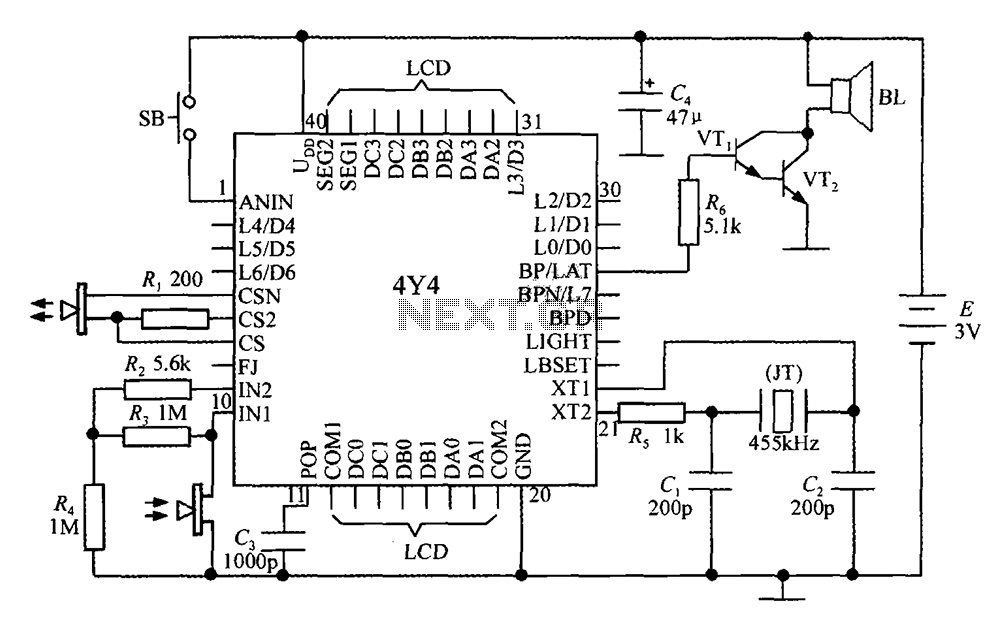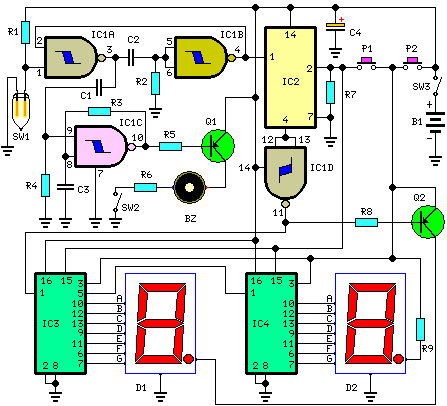
Automatic Porch-Light Control Circuit

The automatic porch-light control circuit maintains a triac in an active state until a 4020 divider counts a series of 60-Hz power line pulses. This circuit is designed to turn off the light after a specified duration, utilizing pins other than pin 3 of the integrated circuit III. Different time intervals can be configured.
The automatic porch-light control circuit is a versatile and efficient solution for controlling outdoor lighting. The core component of this circuit is the 4020 binary counter, which is designed to count pulses from a 60-Hz AC power supply, typically used in residential electrical systems. As the 4020 counts these pulses, it generates a specific output once a predetermined count is reached, which in this case is set to 60. This corresponds to one minute of time, given the frequency of the input signal.
The triac acts as a switch that allows current to flow to the porch light. When the circuit is powered on, the triac is triggered into conduction, illuminating the light. The circuit remains in this state until the 4020 counter reaches the designated count, at which point it sends a signal to deactivate the triac, turning off the light. This functionality is crucial for energy conservation and convenience, ensuring that the light does not remain on indefinitely.
To allow for flexibility in operation, the circuit can be configured to use various pins on the 4020 for timing adjustments. By selecting different output pins, users can set different time intervals for the light to remain on, accommodating various user needs and preferences. This feature enhances the usability of the circuit, making it adaptable to different applications.
For further technical details and specifications, it is recommended to consult the data sheet of the 4020 integrated circuit, which provides comprehensive information on its operation, pin configurations, and timing characteristics. This information is essential for anyone looking to implement or modify the automatic porch-light control circuit effectively. The automatic porch-light control circuit holds a triac on until a 4020 divider counts a number of 60-Hz powerlinc pulses. The circuit turns off a light after a predetermined time by using pins other than pin 3 of III. Various times can be set. Consult the 4020 data sheet for information.
The automatic porch-light control circuit is a versatile and efficient solution for controlling outdoor lighting. The core component of this circuit is the 4020 binary counter, which is designed to count pulses from a 60-Hz AC power supply, typically used in residential electrical systems. As the 4020 counts these pulses, it generates a specific output once a predetermined count is reached, which in this case is set to 60. This corresponds to one minute of time, given the frequency of the input signal.
The triac acts as a switch that allows current to flow to the porch light. When the circuit is powered on, the triac is triggered into conduction, illuminating the light. The circuit remains in this state until the 4020 counter reaches the designated count, at which point it sends a signal to deactivate the triac, turning off the light. This functionality is crucial for energy conservation and convenience, ensuring that the light does not remain on indefinitely.
To allow for flexibility in operation, the circuit can be configured to use various pins on the 4020 for timing adjustments. By selecting different output pins, users can set different time intervals for the light to remain on, accommodating various user needs and preferences. This feature enhances the usability of the circuit, making it adaptable to different applications.
For further technical details and specifications, it is recommended to consult the data sheet of the 4020 integrated circuit, which provides comprehensive information on its operation, pin configurations, and timing characteristics. This information is essential for anyone looking to implement or modify the automatic porch-light control circuit effectively. The automatic porch-light control circuit holds a triac on until a 4020 divider counts a number of 60-Hz powerlinc pulses. The circuit turns off a light after a predetermined time by using pins other than pin 3 of III. Various times can be set. Consult the 4020 data sheet for information.





